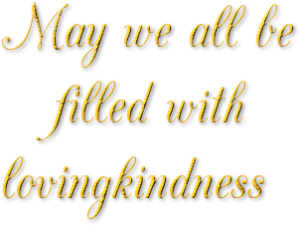 I have been practicing lovingkindness meditation for several months now, so when I read an article in my local newspaper about an anti-bullying program that tries to promote kindness and compassion, I started to wonder if introducing lovingkindness meditation into our schools would help combat bullying.
I have been practicing lovingkindness meditation for several months now, so when I read an article in my local newspaper about an anti-bullying program that tries to promote kindness and compassion, I started to wonder if introducing lovingkindness meditation into our schools would help combat bullying.
The Star Ledger article was about 18 year old Ashley Craig and the non-profit foundation she started, Students Against Being Bullied (SABB), which focuses on setting up “dedicated texting lines in the school to allow bystanders to anonymously report incidents and victims to seek help, safe rooms with staff to provide refuge for students before classes begin, and monthly programs to promote community, kindness and compassion.” I was impressed with Ashley Craig’s passion, determination, inventiveness, and commitment and encourage everybody to check out the foundation’s website (http:studentsagainstbeingbullied.org).
As I reflected on the foundation’s goal of promoting community and kindness, it occurred to me that introducing daily lovingkindness meditation could potentially accomplish even more than monthly programs. So I played around with the idea in my mind and came up with a way for schools to institute lovingkindness meditation as a community practice. First I modified the traditional lovingkindness meditation so the words were particularly relevant to a student population. Then I came up with some ideas of how to implement a year-long lovingkindness project in the schools.
Lovingkindness Meditation for Schools
Start with three full breaths. Breathe in through your nose, imagining you are smelling a flower. Breathe out through your mouth, imagining you are blowing out the candles on a birthday cake. Try to make the out-breaths last as long as possible.
Recite the following out loud:
May I be safe
May I be peaceful
May I be free from suffering
May I be filled with lovingkindness
May I be happy
May my family and friends be safe
May my family and friends be peaceful
May my family and friends be free from suffering
May my family and friends be filled with lovingkindness
May my family and friends be happy
May my classmates be safe
May my classmates be peaceful
May my classmates be free from suffering
May my classmates be filled with lovingkindness
May my classmates be happy
May my teachers be safe
May my teachers be peaceful
May my teachers be free from suffering
May my teachers be filled with lovingkindness
May my teachers be happy
May the entire school be safe
May the entire school be peaceful
May the entire school be free from suffering
May the entire school be filled with lovingkindness
May the entire school be happy
May all people be safe
May all people be peaceful
May all people be free from suffering
May all people be filled with lovingkindness
May all people be happy
Suggested Plan to Implement the Lovingkindness Project in Your School
1. Have a teacher meeting and a parent meeting to introduce the Lovingkindness Project
2. Have an assembly for all students introducing the Lovingkindness Project.
3. For younger grades, have teachers follow up with discussion of what it means to be safe, peaceful, free from suffering, etc.
4. In older grades have teachers lead discussion of the difficulty of having good wishes for people who have harmed you and encourage students to try to include everyone. For those who are unable to include those who have harmed them, encourage them to try to say a separate phrase “May those who have hurt me be filled with lovingkindness”.
5. Say it over the loudspeaker every morning at the same time
6. Have teachers model participation for students
7. After one month ask students to make a pledge to do it every day, including weekends, vacations, sick-days, etc. for the entire year
8. Ask teachers and parents to take the same pledge. Teachers would replace “classmates” and ‘teachers” with “students” and “fellow teachers” in their meditation and parents would change their meditation to include “my child(ren)’s classmates” and “my child(ren)’s teachers.”
9. Continue doing it over the loudspeaker daily
10. After 3 months (or right before thanksgiving) have group discussions about the impact
11. At the end of the year have an essay contest about lovingkindness
Please share this idea on social media and suggest it to schools you are involved with. Together we can make a difference!
Note: If you have any suggestions that could further enhance this project, I would love to hear from you. Please share your ideas on my trauma blog, From Where I Stand. Since this post is cross-posted on both blogs, I disabled comments here so all comments will be in one location.

 The song, The Greatest Love of All, has a lot of meaning for me. I resonate with its lyrics on a deep level. And I love to sing. Singing is one way I express myself. I have fond memories of belting out the words of this song, with great feeling, with a close friend. It was a very empowering experience.
The song, The Greatest Love of All, has a lot of meaning for me. I resonate with its lyrics on a deep level. And I love to sing. Singing is one way I express myself. I have fond memories of belting out the words of this song, with great feeling, with a close friend. It was a very empowering experience.